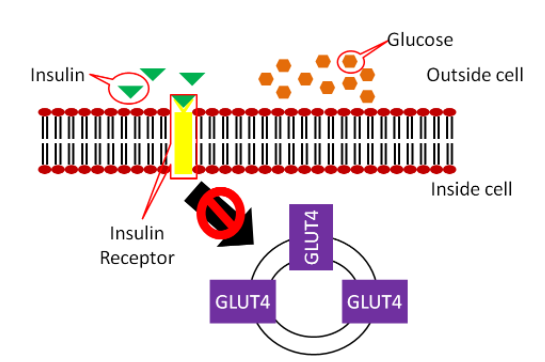4.5A: Diabetes
- Page ID
- 1468
Diabetes is a condition of chronically high blood sugar levels. The prevalence of diabetes in the US has been rapidly increasing; the link below provides some statistics about prevalence.
|
Web Link |
There are 2 forms of diabetes, type 1 and type 2.
In type 1 diabetes, not enough insulin is produced, as shown in the figure below.

Figure 4.512 Type 1 diabetes
As a result, GLUT4 does not make it to the surface of muscle and adipose cells, meaning glucose is not taken up into these cells.
Type 1 diabetes was previously known as juvenile-onset, or insulin-dependent diabetes and is estimated to account for 5-10% of diabetes cases1. Type 1 diabetics receive insulin through injections or pumps to manage their blood sugar.
In type 2 diabetes, the body produces enough insulin, but the person's body is resistant to it. In type 2 diabetics the binding of insulin to its receptor does not cause GLUT4 to move to the surface of the muscle and adipose cells, thus no glucose is taken up.

Figure 4.513 Type 2 diabetes
Type 2 diabetes accounts for 90-95% of diabetes cases and was once known as non-insulin-dependent diabetes or adult-onset diabetes1. However, with the increasing rates of obesity, many younger people are being diagnosed with type 2, making the latter definition no longer appropriate. Some people with type 2 diabetes can control their condition with a diet and exercise regimen. This regimen improves their insulin sensitivity, or their response to the body’s own insulin. Others with type 2 diabetes must receive insulin. These individuals are producing enough insulin, but are so resistant to it that more is needed for glucose to be taken up by their muscle and adipose cells.
The video below illustrates type 2 diabetes. However, I do not agree, nor do I teach, that type 2 diabetics have decreased insulin levels as described in the video.
|
Web Link |
References & Links
- diabetes.niddk.nih.gov/dm/pub...atistics/#what
Link
Diabetes Statisitics - http://www.diabetes.org/diabetes-basics/statistics/
Video
Diabetes Mellitus - http://www.youtube.com/watch?v=VLiTbb6MaEU


